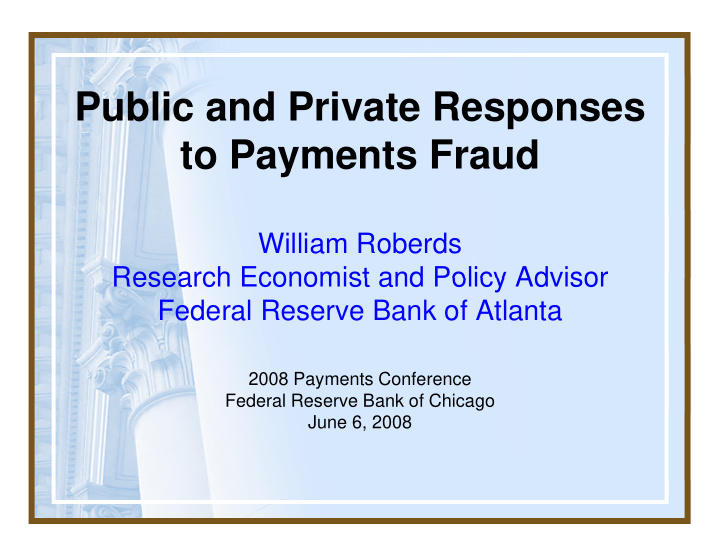



Public and Private Responses t to Payments Fraud P t F d William Roberds Research Economist and Policy Advisor Research Economist and Policy Advisor Federal Reserve Bank of Atlanta 2008 Payments Conference Federal Reserve Bank of Chicago June 6, 2008
Let’s start with a definition f • Economist –Someone who sees something Someone who sees something work in practice and wonders whether it would work in theory Public and Private Responses 2
P Payments fraud through the lens f d h h h l of economic theory of economic theory • Key buzzword • Key buzzword –Services provided by modern Services provided by modern payment systems (including fraud mitigation) can be classified as iti ti ) b l ifi d club goods g Public and Private Responses 3
Club goods: definition Club goods: definition • A club good is – Nonrival (not diminished by successive Nonrival (not diminished by successive use) – Excludable (it is possible to keep parties who have not paid from enjoying parties who have not paid from enjoying good) Public and Private Responses 4
Other club goods • Many so-called “digital goods” –Cable TV programming p g g –Recorded audio/video –Computer software Computer software Public and Private Responses 5
Does the club good idea work Does the club good idea work for payments fraud? p y • Nonrival: almost all fraud mitigation Nonrival: almost all fraud mitigation activities provide group benefit (ensure integrity of given payment system) integrity of given payment system) – Examples: identity verification, authentication, fraud detection database of perpetrators fraud detection, database of perpetrators, security standards • Excludable: benefits only provided to • Excludable: benefits only provided to payment system participants Public and Private Responses 6
Similar yet different Similar, yet different • Fraud mitigation differs from many other club goods g • “Weakest link” club good: total amount of good provided often depends on lowest of good provided often depends on lowest effort provided by any group member • Some weak links: – OfficeMax TJX Hannaford and others OfficeMax, TJX, Hannaford, and others Public and Private Responses 7
Club goods: why interesting to Club goods: why interesting to economists? economists? • “Halfway” between private goods and public goods – Private good is rival and excludable Private good is rival and excludable • Examples: stuff you buy at Wal-Mart – Public good is nonrival and nonexcludable – Public good is nonrival and nonexcludable • Examples: national defense, clean air, criminal justice system justice system Public and Private Responses 8
Implications for role of Implications for role of government g • Private goods: provided by private sector (no govt. takeover of Wal-Mart) • Public goods: provided by public sector Public goods: provided by public sector (no privatization of the Pentagon) • Club goods: provided by private sector Cl b d id d b i t t (Hollywood, Microsoft) but with ( y ) government intervention (intellectual property law, FCC, antitrust) property law, FCC, antitrust) Public and Private Responses 9
How about payments fraud How about payments fraud mitigation ? g As with other club goods As with other club goods • Most fraud mitigation left to private sector • But, government regulation is pervasive and increasing (Regs E&Z ITADA and increasing (Regs. E&Z, ITADA, FACTA, etc.) Public and Private Responses 10
Getting back to the subject Question #1 : What role for government? • Theory of club goods says that by and • Theory of club goods says that, by and large, fraud mitigation is most efficiently undertaken by the private sector d t k b th i t t • Profit motive is key driver of innovation y and cost efficiency Public and Private Responses 11
On the other hand On the other hand • There is an underlying public ( (nonexcludable) good: l d bl ) d – Public’s confidence in innovative payment systems, and overall payments system d ll • (Some) payment system regulation can be ( ) y y g rationalized as a way of maintaining such confidence – Example: 1968 TILA/ Reg Z and credit cards Public and Private Responses 12
Other roles for government • Coordinating industry/consumer efforts • Impartial standards setter • Applying criminal sanctions • Applying criminal sanctions Public and Private Responses 13
Q Question #2: ti #2 In terms of fraud mitigation should In terms of fraud mitigation, should one size fit all? • Theory: No Public and Private Responses 14
Q Question #3: ti #3 How effective are standards in fraud mitigation? • Theory: standards are useful for coordination but cannot resolve inevitable coordination but cannot resolve inevitable conflicts of interest • Players with much at stake must find way Pl ith h t t k t fi d to motivate smaller players, especially for weakest-link goods Public and Private Responses 15
S Summary • Payments fraud mitigation a club good • Payments fraud mitigation, a club good • As with other club goods, private sector provision increases efficiency • Roles for government: • Roles for government: – coordinate standards – facilitate communication – promote confidence p – punish criminal behavior Public and Private Responses 16
Recommend
More recommend